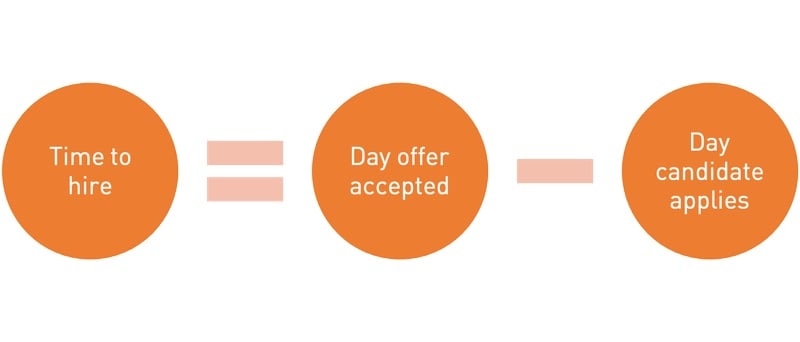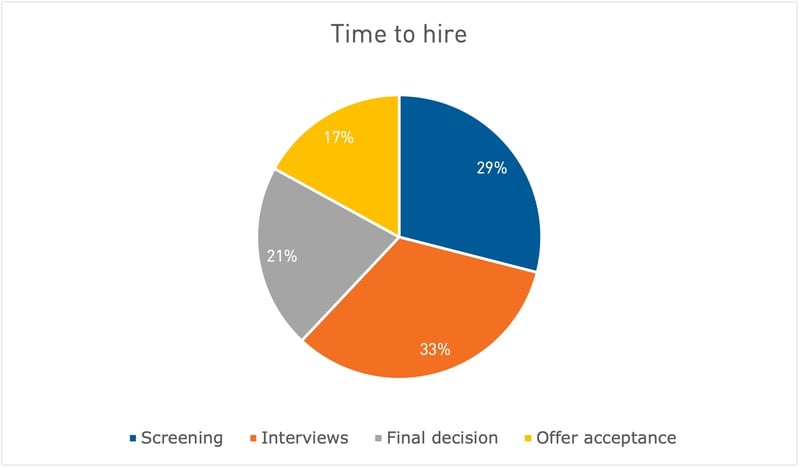How to Measure & Reduce Time to Hire - Candidate Screening
Getting the right talent in the right roles is the number one priority for recruiters. However, despite the critical importance of a quick turnaround, organisations often struggle with long time periods between advertising a job and having an offer accepted by the final candidate.
Research shows the average time to hire is 36 days, and that this time period increases exponentially when dealing with senior roles. Almost 50% of recruiters feel that screening takes up the majority of their time, while 33% feel that interviews are the biggest time drain.
Why is it Important to Measure Time to Hire in your Organisation?
Measuring time to hire is the first step in streamlining your employee selection process. It will help you to understand your biggest time drains and their impact on the quality of talent you’re bringing through the door.
Another key reason to measure your time to hire is cost. There is a direct relationship between time spent on recruitment and how much it ends up costing the organisation.

A faster process results in the following benefits, which indirectly affect cost:
-
Optimising candidate experience, by offering swift feedback on applications
-
Not letting top talent get away, by being able to extend an offer sooner
-
Maintaining team performance, by filling gaps sooner
How to Measure Time to Hire
Time to hire should be differentiated from time to fill.
-
Time to fill measures how long it takes an organisation to fill an open position, including the time taken to approve the job profile, approve the job advert, advertise the role and find a suitable pool of talent.
-
Time to hire is far more relevant to recruiters as it reflects the efficiency of the selection process. It measures how long it takes a candidate to move through the organisation’s recruitment funnel, and how long each stage takes.
Time to hire is measured by calculating the number of days from candidate application to the day the candidate accepts an offer. This can then be averaged across roles and across time. Better yet, if you’re able to calculate the number of days each stage takes in your recruitment funnel, you can sum this together to get your total time to hire.

Time to Hire Example:
-
1 June: Company X advertises for a sales manager.
-
5 June: Sam Sample applies for the role. This is where you start to calculate time to hire.
-
10 June: After screening Sam Sample’s CV, he is invited for an interview (5 days)
-
16 June: Sam Sample attends an interview (6 days).
-
17 June: After reviewing the first interview, Sam Sample is invited for a second interview (1 day).
-
19 June: Sam Sample attends his second interview (2 days).
-
24 June: Sam Sample receives an offer for the sales manager role (5 days).
-
27 June: Sam Sample accepts the offer for the sales manager position (3 days).
Time to hire = 27 June (Day offer is accepted) - 5 June (Day candidate applies for the position) = 22 days
Using Time to Hire to Improve your Candidate Screening and Recruitment Process
SHRM's Talent Acquisition Benchmarking report shows that the majority of recruitment time is taken up by screening and interviews. This means that 62% of the hiring funnel is within your control to streamline and automate.

Once you’ve tracked your metrics and have an idea of where you want to focus, there are some simple ways to reduce your time to hire.
Introduce Structure to your Hiring Process
In some cases, longer time to hire and cost to hire can be linked to an unstructured recruitment process. Sketch out your current process and document the candidate journey from start to finish. Compare this to your data, benchmarks and best practices.
Optimise Interviews to Save Time
Interviews are one of the most significant time drains in the recruitment process. Luckily, there are a number of technology-driven solutions that can be explored, such as:
-
Written, structured interviews.
-
Video-based interviews.
-
AI interviews, where the candidate speaks to a “bot”.
-
Video scheduling software.
Use Technology to Automatically Screen and Shortlist Candidates
The traditional approach to recruitment emphasises time-heavy manual review of candidate CVs. An automated, online screening approach, however, uses technology from the very first stage: to screen for hard criteria (non-negotiables) and assess candidate potential against the role. This drastically reduces the time and resource demands on the organisation, especially for high volume positions, while providing a shortlist of top talent to move through the recruitment pipeline.
Screening all applicants using technology gives everyone the opportunity to demonstrate their potential, with Zero talent Waste. It reduces bias by first assessing objective, measurable criteria with the strongest predictive power. It relies on online software to automatically rank applicants, provide candidate feedback, measure competency role fit, analyse group dynamics and more.
The first two phases of the recruitment funnel are completely automated and talent led. Shortlisted candidates are interviewed using their talent insights to improve process efficiency and outcomes.
Find out more about Zero Talent Waste Online Screening
Lumenii South Africa recommends the use of Ascend, an online volume candidate screening platform that allows you to assess all applicants at a fixed-cost. Clients who make use of Ascend report up to 90% time savings and a 9x more efficient recruitment process.
Download our infographic on the ROI of a technology-driven approach to candidate screening, and request a no-strings-attached screening demo to find out more.
Author
Lumenii's team of expert psychologists regularly collaborate to share their ideas and knowledge. The latest case studies, thought leadership, and research.